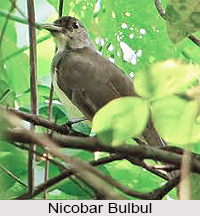 Nicobar Bulbul is an Indian bird found only on the Andaman and Nicobar Islands of India.
Nicobar Bulbul is an Indian bird found only on the Andaman and Nicobar Islands of India.
Category of Nicobar Bulbul
Nicobar Bulbul is a songbird species in the bulbul family of Pycnonotidae. The scientific name of Nicobar bulbul is Ixos virescens.
Size of Nicobar Bulbul
Nicobar Bulbul is 20 cm-long bulbul which is a rather drab, nondescript species without a crest. Its wings, back and tail are dull dusky green; the face is lighter, and the throat and underside are yellowish-white. The most prominent feature is a sooty-brown cap reaching down to eye height.
Calls of Nicobar Bulbul
Nicobar Bulbul produces chattering calls, similar to those of the black bulbul (H. leucocephalus).
Habitat of Nicobar Bulbul
Nicobar Bulbul is endemic to the Nicobar Islands of India, where it only occurs in the central group, namely Bompoka, Camorta, Katchall, Nancowry, Teressa, Tillanchong and Trinkat.
Natural Habitat of Nicobar Bulbul
The natural habitats of Nicobar Bulbul are subtropical and tropical moist lowland primary and secondary forest. It also visits plantations, rural gardens, and occasionally urban areas and grassland. In the early 1990s though the species was still found on every major island in its range, only single birds or families were usually seen except on Katchall and Teressa. Only in some places on the former it was still as common then as it used to be 100 years ago. At present, it manages to hold its own, but only barely, and habitat loss may have been severe enough to accelerate its decline to dangerous proportions.
Nicobar bulbul and Andaman red-whiskered bulbul
Also, Andaman Red-Whiskered Bulbul was introduced to Camorta by the British; it was later brought to other islands in the Nancowry group by locals, who, like many people elsewhere, consider the Red-Whiskered Bulbul a popular pet. The two bulbuls presumably compete for food, nesting locations and other resources, and if the human-assisted P. J. Whistleri is not actually displacing H. Virescens, being well-established on Katchall, Nancowry, Teressa and Trinkat it is certainly keeping the Nicobar Bulbul`s population lower than it could be. On the other hand, there is no reason to suppose that the native species is an inferior competitor; rather the two bulbuls` populations soon seem to reach equilibrium: on Katchall the Red-Whiskered Bulbul was established in the 1910s or so already, and this has not prevented healthy Nicobar Bulbul stocks from persisting on that island to our time.
Nicobar Bulbul and the Tsunami
The Nicobar Islands were hit hard by the 2004 Indian Ocean tsunami, and the central group was perhaps most severely affected, with at least hundreds, maybe thousands of its inhabitants dead. On Katchall there was perhaps the highest loss of life in the entire Nicobars, but this was to catastrophic destruction of settled areas and much of the island`s interior forest was not affected. Trinkat was literally torn into three pieces, while on Camorta flooding was extreme in the northern part only. Nancowry on the other hand suffered rather little damage overall. On Teressa, the low-lying plains suffered extensive flooding, bisecting the island in fact, but the remaining forest fragments are mostly confined to the hills and were spared. Bompoka and Tillanchong, though small, are quite steep and consequently were not much affected. Though the effect of the Nicobar bulbul"s population on Trinkat has been devastating, the tsunami is not known to have significantly harmed the overall stocks of the species.



















